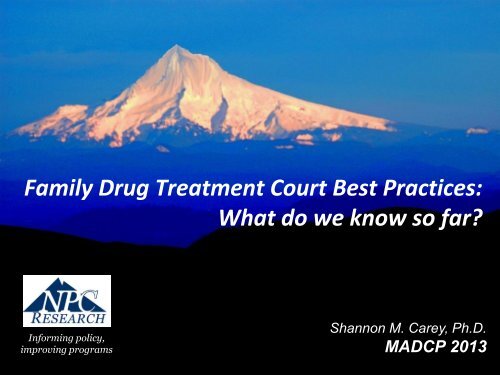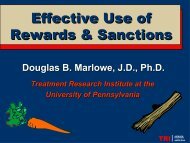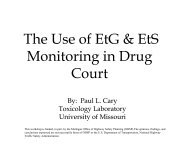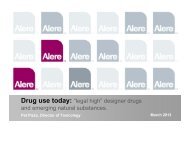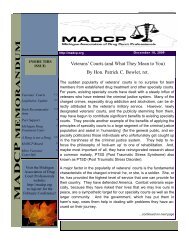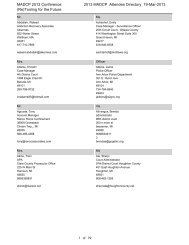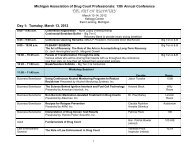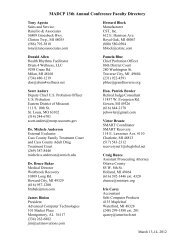1H_Carey_FDTC Best Practices MADCP 2013.pdf
1H_Carey_FDTC Best Practices MADCP 2013.pdf
1H_Carey_FDTC Best Practices MADCP 2013.pdf
Create successful ePaper yourself
Turn your PDF publications into a flip-book with our unique Google optimized e-Paper software.
Overview1. Research about the effectivenessof <strong>FDTC</strong>2. Who does it work for?3. What works: <strong>Best</strong> practices4. What about best practices in non-<strong>FDTC</strong>’s: Do they apply?
RESEARCH ON FAMILY DRUG TREATMENT COURTSWhat do we know about family drug treatmentcourt outcomes?
RESEARCH ON FAMILY DRUG TREATMENT COURTSAshford, J. (2004)Boles, S., & Young, N. K. (2011, July).<strong>Carey</strong>, S. M., Mackin, J. R., & Finigan, M. W. (2012).<strong>Carey</strong>, S. M., Sanders, M. B., Waller, M. S., Burrus, S. W. M., &Aborn, J. A. (2010a, 2010b)Connell, C., Bergeron, N., Katz, K., Saunders, L., & Tebes, J.(2007).Green, B. L., Furrer, C. J., Worcel., S. D., Burrus, S. W. M., &Finigan, M. W. (2009)Harwin, J., Ryan, M., Tunnard, J., Pokhrel, S., Alrouh, B., Matias,C., & Momenian-Shneider, S. (2011, May)Worcel, S. D., Green, B. L., Furrer, C. J., Burrus, S. W. M., &Finigan, M. A. (2007, March)
Outcome EvaluationsLocation(s)Guardian treatmentcompletionTime in fostercareFamilyreunificationPima County, AZSacramento, CAKing County, WABaltimore, MDJackson County, ORMarion County, ORLondon, EnglandSanta Clara, CASuffolk, NYWashoe, NVBelfast, Augusta &Lewiston, MEHillsborough County, FL*p < .05; **p < .01; ***p < .001; †p-value not reported.
RESEARCH ON FAMILY DRUG TREATMENT COURTSExample:Detailed Process, Outcome and Cost Evaluation oftwo Oregon <strong>FDTC</strong>s (<strong>Carey</strong> et al., 2011)
DO <strong>FDTC</strong> parents stay in treatment longerthan non-<strong>FDTC</strong> parents?(JACKSON COUNTY, OREGON)YES. In the year after drug court entry, the <strong>FDTC</strong> program parentsspent nearly twice as long in treatment than parents who did notparticipate in the program.Days in Outpatient Drug Treatment14012012611210080606740200Graduates(N=150)All Drug Court(N=317)Comparison(N=251)Note: Difference is significant at p
Do <strong>FDTC</strong> parents complete treatment moreoften than non-<strong>FDTC</strong> parents?(JACKSON COUNTY, OREGON)YES. Significantly more <strong>FDTC</strong> program parents successfully completedtreatment after program entry compared to parents who did notparticipate in the <strong>FDTC</strong>.100%90%80%70%60%50%40%30%20%10%0%Percent of Parents that Successfully Completed aTreatment Episode87%Graduates(N=152)73%All <strong>FDTC</strong> Court(N=329)44%Comparison(N=340)Note: Difference is significant at p
Outcome EvaluationsLocation(s)Guardian treatmentcompletionTime in fostercareFamilyreunificationPima County, AZSacramento, CAKing County, WABaltimore, MDJackson County, ORMarion County, ORLondon, EnglandSanta Clara, CASuffolk, NYWashoe, NVBelfast, Augusta &Lewiston, MEHillsborough County, FL*p < .05; **p < .01; ***p < .001; †p-value not reported.
Outcome EvaluationsLocation(s)Guardian treatmentcompletionTime in fostercareFamilyreunificationPima County, AZ +17%Sacramento, CA + 9%*King County, WA +33%**Baltimore, MD +28%**Jackson County, OR +29%***Marion County, OR +26*London, EnglandSanta Clara, CA +37%***Suffolk, NY +29%***Washoe, NV +25%**Belfast, Augusta & +32%*Lewiston, MEHillsborough County, FL*p < .05; **p < .01; ***p < .001; †p-value not reported.
Do children of parents who participate in<strong>FDTC</strong> spend less time in foster care?(MARION COUNTY, OREGON)YES. Children of <strong>FDTC</strong> parents spent significantly less time in fostercare in the 2 years after drug court entry than children of non-<strong>FDTC</strong>parents.Days in Foster Care per Child450400350300250200150100500160Graduates(N=13)211All Drug Court(N=39)383Comparison(N=49)Note: Difference is significant at p
Outcome EvaluationsLocation(s)Guardian treatmentcompletionTime in fostercareFamilyreunificationPima County, AZ +17%Sacramento, CA + 9%* - 17 daysKing County, WA +33%** - 208 days***Baltimore, MD +28%** - 94 days**Jackson County, OR +29%*** - 100 days*Marion County, OR +26* - 172 days**London, England- 195 days†Santa Clara, CA +37%*** - 67 days**Suffolk, NY +29%*** + 2 daysWashoe, NV +25%** - 165 days***Belfast, Augusta & +32%*Lewiston, ME- 99 daysHillsborough County, FL+100 days***p < .05; **p < .01; ***p < .001; †p-value not reported.
Are <strong>FDTC</strong> children returned to their parentsmore quickly after drug court start?YES. Children whose parents participated in the <strong>FDTC</strong> program werereturned in less than half the time than children whose parents didnot participate.Days to ReunificationComparison298364<strong>FDTC</strong>1422670 100 200 300 400Jackson MarionNote: Difference is significant at p
Are <strong>FDTC</strong> parents reunified with theirchildren more often?YES. <strong>FDTC</strong> parents were reunified with their children significantly moreoften while experiencing significantly fewer adoptions and terminationof parental rights.90%80%70%60%50%40%30%20%10%0%Percent of Parents that were Reunified with TheirChildren80%51%<strong>FDTC</strong> CourtMarionJackson40%45%ComparisonNote: Difference is significant at p
Outcome EvaluationsLocation(s)Guardian treatmentcompletionTime in fostercareFamilyreunificationPima County, AZ +17% +22%Sacramento, CA + 9%* - 17 days +18%***King County, WA +33%** -208 days*** +17%***Baltimore, MD +28%** - 94 days** +25%**Jackson County, OR +29%*** -100 days* + 6%*Marion County, OR +26* -172 days** + 40%**London, England -195 days† +18%†Santa Clara, CA +37%*** - 67 days** +32%***Suffolk, NY +29%*** + 2 days + 2%Washoe, NV +25%** -165 days*** +46%***Belfast, Augusta & +32%* - 99 days - 4%Lewiston, MEHillsborough County, FL +100 days** +11%***p < .05; **p < .01; ***p < .001; †p-value not reported.
Do <strong>FDTC</strong> parents have fewer subsequentarrests than non-<strong>FDTC</strong> parents?(JACKSON COUNTY, OREGON)YES. Drug court participants were re-arrested significantly less often thanthe comparison group over 4 years from drug court entry.70%60%50%40%30%20%10%10%30%25%50%41%34% 35%17% 18%20%40%63%GraduateAll ParticipantsComparison0%1 Year 2 years 3 years 4 yearsNote: Difference is significant at p
Savings per Participant by Agency(Criminal Justice, Treatment and Child Welfare)(MARION COUNTY, OREGON)TotalChild Welfare$13,104$13,996Treatment (OHP)Law Enforcement AgenciesOregon DOCPublic DefenderDistrict AttorneyCircuit Court($3,794)$481$1,368$179$430$444($5,000) $0 $5,000 $10,000 $15,000
Outcome Costs per Participant(Criminal Justice, Treatment and Child Welfare)Cost savings after 2 years wasMarion = $13,104Jackson = $5,593per <strong>FDTC</strong> participant
What was different?Look at the investment costs
PROGRAM COST PER PARTICIPANT BY AGENCYAgencyJACKSON COUNTYAverage cost per CFCparticipantCircuit Court $1,392DHS $3,653Health and Human Services $320Addictions Recovery Center $188Access, Inc. $215Community Works $210OnTrack, Inc. $385CASA $99Family Nurturing Center $67Southern Oregon Public Defender, Inc. $57Treatment $5,561Total $12,147Of the total investment cost, largest was tx (45%)
PROGRAM COST PER PARTICIPANT BY AGENCYMARION COUNTYAverage cost perFATCAgencyparticipantCircuit Court $1,685DHS $2,814Health Department $787Parole and Probation $728Family Building Blocks $3,003Valley Mental Health $892Treatment (OHP) $4,442Total $14,351Of the total investment cost, largest was tx (31%)
What was different?Marion: Of the investment budget• 31% went to D&A treatment• 20% to DHS• 21% for services for the child (often withthe parent).Jackson: Of the investment budget:• 45% went to D&A treatment• 30% to DHS• 5% for services for the child.
<strong>FDTC</strong> <strong>Best</strong> <strong>Practices</strong>Focus on services to child and parents,particularly together
% Reduction inRecidivism<strong>FDTC</strong> <strong>Best</strong> <strong>Practices</strong>(ADC) Drug courts that offer parenting classes have68% greater reductions in recidivism and 52%greater cost savings38%23%Program providesparenting classesN=44Program does NOTprovide parentingclassesN=17 True in adult, family, juvenile
<strong>FDTC</strong> <strong>Best</strong> <strong>Practices</strong>Decrease Time to Treatment EntryTime to EntryTime in Foster CareLikelihood ofReunification
Percent reductions in recidivismDrug Courts In Which Participants Entered theProgram within 50 Days of the Incident Had63% Greater Reductions in Recidivism50%39%40%30%24%20%10%0%Participants enterprogram within50 days of incidentN=15Participants enterprogram greater than50 days from incidentN=26Note: Difference is significant at p
<strong>FDTC</strong> <strong>Best</strong> <strong>Practices</strong>Frequent counseling sessions:Participants who met more frequently withtheir counselors (weekly)• Stayed in treatment longer• Were more likely to complete treatmentPrograms where participants who had one-ononetreatment at least once every 3 weekshad 56% greater reductions in recidivism
<strong>FDTC</strong> <strong>Best</strong> <strong>Practices</strong>Longer Time in Treatment (~15 months)Time in Foster CareReunificationTime in Treatment
<strong>FDTC</strong> <strong>Best</strong> <strong>Practices</strong>Longer Time in Treatment% reduction in recidivism % increase in cost savings0.60.50.40.30.20.10Less than 12months12 months 18 months 24 monthsIntended Length of Program
What about ASFA?
What about ASFA?Many <strong>FDTC</strong> programs:• Incorporate ASFA guidelines into theirprogram plan• But do not expect participants to graduatebefore their children are returned, and donot terminate their participants if childrenare not returned• Program should be closely tied to childwelfare plan and requirements
<strong>FDTC</strong> <strong>Best</strong> <strong>Practices</strong>Relationship with JudgeFocus groups with <strong>FDTC</strong> participants indicatethey perceived their interactions with thejudge to be especially critical to their successin the program.
Percent reduction inrecidivism<strong>FDTC</strong> <strong>Best</strong> <strong>Practices</strong>Relationship with JudgeDrug Courts Where the Judge Spends an Average of 3 Minutes orGreater per Participant During Court Hearings had 153%greater reductions in recidivism50%40%30%20%10%0%43%Judge spends atleast 3 min. perparticipantN=2317%Judge spendsLESS THAN 3 min.per participantN=12
Drug Courts Where the Judge Spends an Average of 3 Minutes orGreater per Participant During Court Hearings had 153%greater reductions in recidivismNote 1: Difference is significant at p
<strong>FDTC</strong> <strong>Best</strong> <strong>Practices</strong>Urine drug testingParticipants who were subjected to morefrequent urine drug screens remained intreatment longer and were more likely tocomplete treatment (Worcel et al., 2007).
Percent increase in costsavings<strong>FDTC</strong> <strong>Best</strong> <strong>Practices</strong>Urine drug testingDrug Courts Where Drug Tests are Collectedat Least Two Times per Week In the First Phase had61% Higher Cost Savings40%30%20%10%0%29%Participants drugtested at least 2Xper weekN=5318%Participants testedLESS often than 2Xper weekN=12Note 1: Difference is significant at p
<strong>FDTC</strong> <strong>Best</strong> <strong>Practices</strong> Drug courts where drug test results areback in 48 hours or less had 68% highercost savings Drug courts that offered family/domesticrelations counseling have 65% greaterreductions in recidivism Drug courts that expected participants tohave greater than 90 days clean beforegraduation had 3 times greater reductionsin recidivism
<strong>FDTC</strong> <strong>Best</strong> <strong>Practices</strong> Drug courts where a representative fromtreatment attends staffings had 2 timesgreater reductions in recidivism Drug courts where the defense attorneyattends staffings had 93% greater costsavings Drug courts where sanctions areimposed immediately after noncompliantbehavior had twice the costsavings
<strong>FDTC</strong> <strong>Best</strong> <strong>Practices</strong> Drug courts where the judge attendedstaffings had nearly 4 times greaterreductions in recidivism Drug courts where the results of programevaluations have led to modifications indrug court operations had 2 timesgreater cost savings Drug courts where the program caseload(number of individuals actually participatingat any one time) is less than 125 had 6times greater reductions in recidivism
Who do FDC’s Work For?Equivalent or Better Outcomes:• Co-occurring mental health problems• Unemployed• Less than a high school education• Criminal history• Inadequate housing• Risk for domestic violence• Methamphetamine, crack cocaine, or alcohol(e.g., Boles & Young, 2011; <strong>Carey</strong> et al. 2010a, 2010b; Worcel et al., 2007)
Adult <strong>Best</strong> <strong>Practices</strong>Do They Apply to <strong>FDTC</strong>s? Drug courts that require participants tohave a job or be in school in order tograduate had twice the cost savings Drug courts where law enforcement is amember of the drug court team had 44%increase in cost savings Drug courts that use greater jail time hadsignificantly worse outcomes
More jail time is related toworse outcomesPercent difference in recidivism between courts thatuse differing amounts of jail sanction time40%20%0%-20%1 day 2 days 3-6 days 1 week 2 weeks > 2 weeks-40%-60%-80%-100%Percent Difference inrecidivism-120%-140%-160%Typical length of a jail sanction
More jail time is related toworse outcomes40%20%Savings% cost savings0%-20%1 day 2 days 3-6 days 1 week 2 weeks > 2 weeks-40%-60%-80%Loss-100%Typical length of a jail sanction
Questions?Thoughts?Comments?
Contact InformationShannon M. <strong>Carey</strong>, Ph.D.carey@npcresearch.comTo learn more about NPC or more about drug courtevaluations including cost-benefit evaluations see:www.npcresearch.com46


